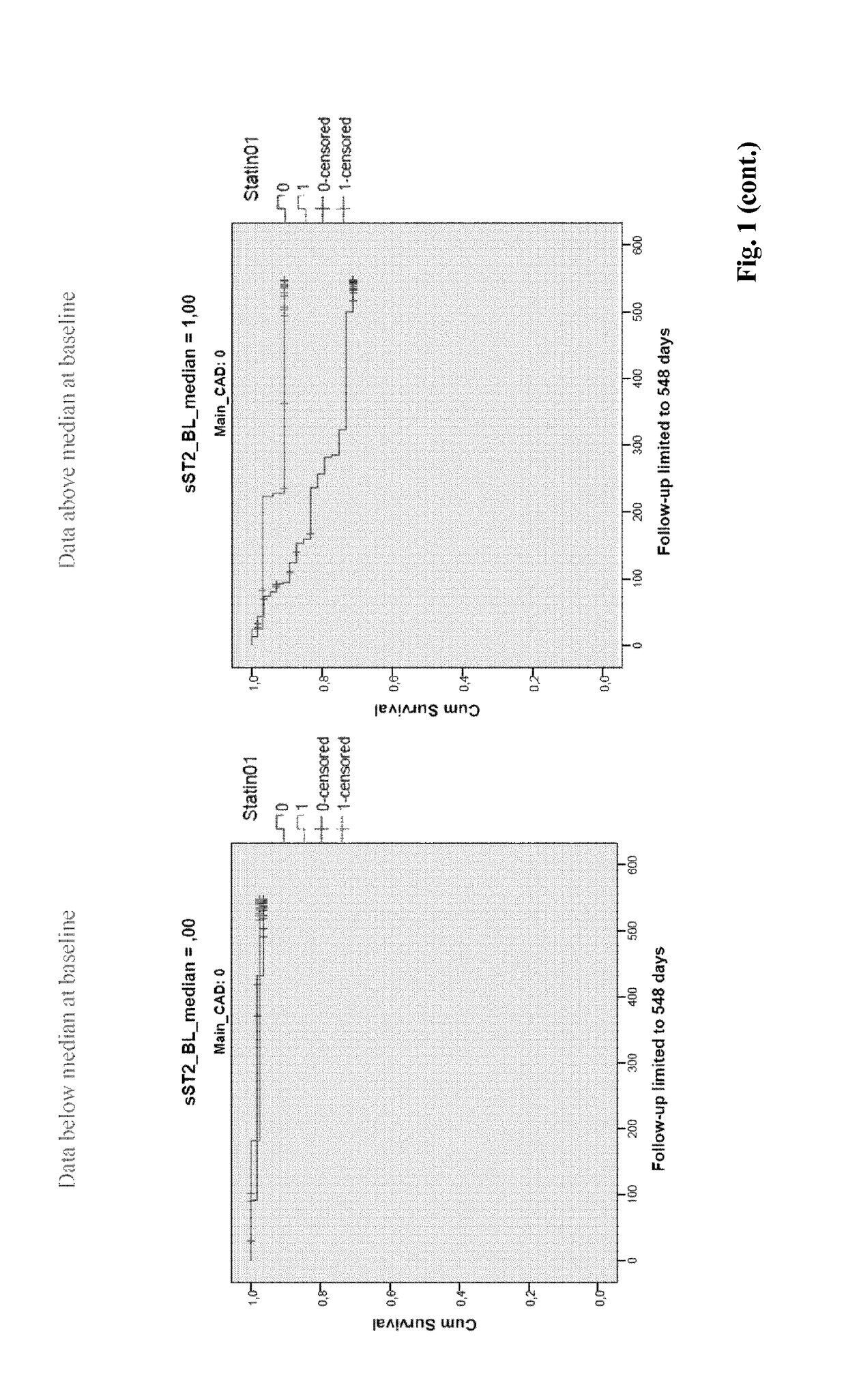Marker for statin treatment stratification in heart failure
a statin treatment and stratification technology, applied in cardiovascular disorders, drug compositions, instruments, etc., can solve the problems of not being able to demonstrate the benefit the effect of statin treatment on the primary end point of both trials cannot be substantiated in an analysis, and the use of statin therapy in chronic heart failure (chf) is not supported by major guidelines
- Summary
- Abstract
- Description
- Claims
- Application Information
AI Technical Summary
Benefits of technology
Problems solved by technology
Method used
Image
Examples
example 1
ohort
[0388]Potential biomarker candidates for statin therapy stratification were measured in plasma samples from 499 patients suffering from HF (NYHA class II-IV HF (LVEF ≤45%) (Pfisterer M. et al. JAMA. 2009; 301:383-92). The biomarkers were measured at baseline and the subgroups below and above the median were associated with outcomes after 18 months of therapy. Additionally, patients were stratified for the presence of statin therapy and CAD (see Figures). 211 patients were not on statin therapy and 288 patients received statin therapy. Furthermore, 212 patients did not have Coronary Artery Disease (CAD) and 287 had CAD.
example 2
[0389]Troponin T was determined using Roche's electrochemiluminescence ELISA sandwich test ELECSYS™ Troponin T hs (high sensitive) STAT (Short Turn Around Time) assay. The test employs two monoclonal antibodies specifically directed against human cardiac troponin T. The antibodies recognize two epitopes (amino acid position 125-131 and 136-147) located in the central part of the cardiac troponin T protein, which consists of 288 amino acids. The hs-TnT assay allows a measurement of troponin T levels in the range of 3 to 10000 pg / mL.
[0390]IL-6 (Interleukin 6) was measured by an electrochemiluminescent immunoassay (ECLIA, Roche Diagnostics). The test was performed using a COBAS® E601 analyzer from Roche Diagnostics. The test is based on a first incubation with a biotinylated monoclonal IL-6-specific antibody and a second incubation with a monoclonal IL-6-specific antibody labeled with a ruthenium complex and streptavidin-coated microparticles.
[0391]High-sensitive (hs) CRP was determine...
example 3
[0400]The analysis described in above led to the following statin therapy response predictions.[0401]Osteopontin (OPN) levels below (but not above) median tend to predict the therapy response to statins in HF patients without CAD (but not in patients with CAD)[0402]sST2 levels below median predict the therapy response to statins in HF patients in patients without CAD (p=0.04)[0403]GDF-15 levels above the median predict the therapy response to statins in HF patients without CAD; conversely, GDF-15 levels below the median predict the therapy response to statins in HF patients with CAD (both p=0.04)[0404]Urea levels above (but not below) the median predict the therapy response to statins in HF patients with CAD (p=0.02) and with a trend also in patients without CAD (p=0.10)[0405]Uric acid levels below (but not above) median predict the therapy response to statins in HF patients with CAD (p=0.03), but less so in patients without CAD (p=0.09)[0406]Transferrin levels above (but not below)...
PUM
| Property | Measurement | Unit |
|---|---|---|
| molecular weight | aaaaa | aaaaa |
| molecular weight | aaaaa | aaaaa |
| molecular weight | aaaaa | aaaaa |
Abstract
Description
Claims
Application Information
 Login to View More
Login to View More - R&D
- Intellectual Property
- Life Sciences
- Materials
- Tech Scout
- Unparalleled Data Quality
- Higher Quality Content
- 60% Fewer Hallucinations
Browse by: Latest US Patents, China's latest patents, Technical Efficacy Thesaurus, Application Domain, Technology Topic, Popular Technical Reports.
© 2025 PatSnap. All rights reserved.Legal|Privacy policy|Modern Slavery Act Transparency Statement|Sitemap|About US| Contact US: help@patsnap.com



